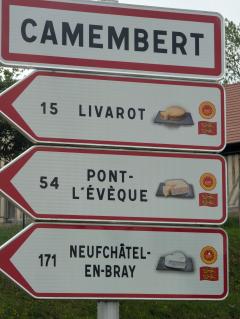 This was a great day! We got an early start and explored the old city of Rouen, including the cathedral and the Ancien Marche, then we went to Giverny to see Monet's gardens and house, then up through the Pays d'Auge dairy country to see the other classic cheeses and the apple orchards and calvados distilleries, the beautiful little town of Beuvron-en-Auge, and finally to the resort-beach town of Cabourg on the shores of La Manche (the French term for the English Channel).
This was a great day! We got an early start and explored the old city of Rouen, including the cathedral and the Ancien Marche, then we went to Giverny to see Monet's gardens and house, then up through the Pays d'Auge dairy country to see the other classic cheeses and the apple orchards and calvados distilleries, the beautiful little town of Beuvron-en-Auge, and finally to the resort-beach town of Cabourg on the shores of La Manche (the French term for the English Channel).
There were four broad parts to the day's itinerary: exploring Rouen in the early morning, then Giverny in the late morning. The afternoon would be exploring the farm country with a focus on cheese, cider, and Calvados (an aged apple brandy similar to Cognac), and in the evening we would reach Cabourg, a lovely place in its own right, but also the first of several major sites to see in my personal Proust Project.
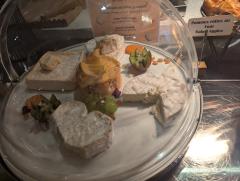 I got up early enough to see the street-sweeper drive by under my window, and hastened downstairs to grab something to eat before hitting the ancient streets to find some must-see sites before Lorna and Melissa were ready to head out. I was happy to see on the breakfast buffet a selection of the four classic Normandy cheeses: You see the heart-shaped Neufchatel in front, then behind to the left we see the square Pont-l'Évêque, the pungent washed-rind Livarot in the middle, and the famous Camembert on the right. The people of Normandy are proud of their cheeses and they are readily available in complete sets like this in many restaurants.
I got up early enough to see the street-sweeper drive by under my window, and hastened downstairs to grab something to eat before hitting the ancient streets to find some must-see sites before Lorna and Melissa were ready to head out. I was happy to see on the breakfast buffet a selection of the four classic Normandy cheeses: You see the heart-shaped Neufchatel in front, then behind to the left we see the square Pont-l'Évêque, the pungent washed-rind Livarot in the middle, and the famous Camembert on the right. The people of Normandy are proud of their cheeses and they are readily available in complete sets like this in many restaurants.
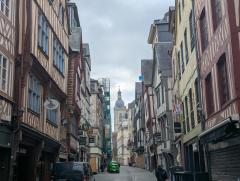 My first objective when I got out the door was a walk to the Ancien Marche. The streets were colorful; there was the Grand Horologue, and the colorful Norman-style half-timbered houses crowded in on both sides. We saw this style of architecture throughout Normandy, especially in the the central and coastal areas. It's similar to the English Tudor-style architecture, but there are many more colors in use, mostly pastel pinks, mints, and creams, and it is notably less geometrically rigid. I don't know the inner details, but those two visible ones gave me a very clear sense that I was not in England.
My first objective when I got out the door was a walk to the Ancien Marche. The streets were colorful; there was the Grand Horologue, and the colorful Norman-style half-timbered houses crowded in on both sides. We saw this style of architecture throughout Normandy, especially in the the central and coastal areas. It's similar to the English Tudor-style architecture, but there are many more colors in use, mostly pastel pinks, mints, and creams, and it is notably less geometrically rigid. I don't know the inner details, but those two visible ones gave me a very clear sense that I was not in England.
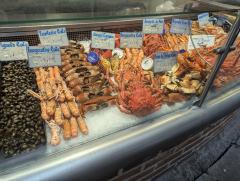 I had set out early to find the market, because Melissa wanted to see the market as the historical site where Jeanne d’Arc was burned for the heresy of wearing men's clothing; I wanted to be sure that I knew how to get there and back. The market was just opening, but it was already full of local produce, fish, and cheeses. Regular readers may recall the adventure that I had in Venice trying to find spider crab for their traditional Granseola, and in the end I was ecstatic to have a shell to bring home and frame in my dining room. (In fact, at one point Owen and I had found some in the Mercato de Rialto only to have the last few bought by a local restaurateur who stepped in front of us!) Here in Rouen they were stacked up in the public market!
I had set out early to find the market, because Melissa wanted to see the market as the historical site where Jeanne d’Arc was burned for the heresy of wearing men's clothing; I wanted to be sure that I knew how to get there and back. The market was just opening, but it was already full of local produce, fish, and cheeses. Regular readers may recall the adventure that I had in Venice trying to find spider crab for their traditional Granseola, and in the end I was ecstatic to have a shell to bring home and frame in my dining room. (In fact, at one point Owen and I had found some in the Mercato de Rialto only to have the last few bought by a local restaurateur who stepped in front of us!) Here in Rouen they were stacked up in the public market!
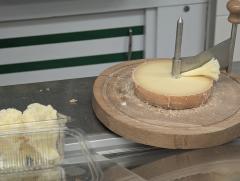 When Melissa was mobile I took her back. Things were more in swing, and we saw a young fellow making Tetes de Moine from Gruyere cheese. Gruyere is an Alpine cheese with no connection to Normandy, but the Tete de Moine is so cute that every cheesemonger loves to show it. As the blade scrapes across the cheese surface, it peels up a thin sheet that naturally ruffles and curls into rosettes that are packaged for sale. You can buy it sometimes in New England, I served some at the Old Colony Club's 2025 Twelfthnight Party that I bought somewhere locally. At the Marche I bought a box so Melissa could try it, and to bring back to the hotel along with some cannele and madeleines that I had bought at Paul.
When Melissa was mobile I took her back. Things were more in swing, and we saw a young fellow making Tetes de Moine from Gruyere cheese. Gruyere is an Alpine cheese with no connection to Normandy, but the Tete de Moine is so cute that every cheesemonger loves to show it. As the blade scrapes across the cheese surface, it peels up a thin sheet that naturally ruffles and curls into rosettes that are packaged for sale. You can buy it sometimes in New England, I served some at the Old Colony Club's 2025 Twelfthnight Party that I bought somewhere locally. At the Marche I bought a box so Melissa could try it, and to bring back to the hotel along with some cannele and madeleines that I had bought at Paul.
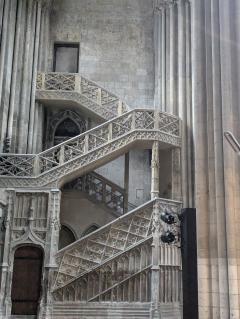 We went to Rouen Cathedral and examined the exterior until it opened at 9:00 with a mighty clangor of the bells far above in the Butter Tower, named for the business of the butter merchants who provided the money for its construction. The cathedral exterior, especially the front, was badly treated by the English occupiers in the 15th century, with much damage including headless statues and other damage that looked like it had been an idle pastime for violent brutes with ammunition and time on their hands.
We went to Rouen Cathedral and examined the exterior until it opened at 9:00 with a mighty clangor of the bells far above in the Butter Tower, named for the business of the butter merchants who provided the money for its construction. The cathedral exterior, especially the front, was badly treated by the English occupiers in the 15th century, with much damage including headless statues and other damage that looked like it had been an idle pastime for violent brutes with ammunition and time on their hands.
Inside the cathedral was in better shape. It's been a major cathedral for centuries and it has some beautiful stonework like these internal stairs. The altars and side chapels were beautiful, and the stained glass windows were glorious. We didn't spend a lot of time inside because we'd had to wait for it to open and we needed to get on the road, but what we saw was exalting and amazing.
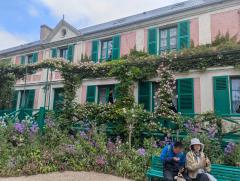 We had breakfast at the hotel, loaded up the car, and we finally got on the road for the boring hour drive on the highway south to Giverny. We were almost an hour late for our 10:30 timed entry, but it was OK.
We had breakfast at the hotel, loaded up the car, and we finally got on the road for the boring hour drive on the highway south to Giverny. We were almost an hour late for our 10:30 timed entry, but it was OK.
The place is terribly disorganized! There were throngs of people from everywhere, including motor coaches and school trips. There was little signage, and unlike many places that we had been, little was in English. What there was was sometimes contradictory, so people formed one long line to the house gate and anxiously asked each other if they were in the right place. They were.
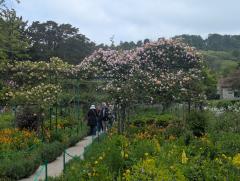 An hour later many of them were gone. It seems there's a crush when they open that passes in an hour or two, so knowing that, if I return someday I will do it later in the day. If it's hot, the water garden with the bridge and the water lilies is shady.
An hour later many of them were gone. It seems there's a crush when they open that passes in an hour or two, so knowing that, if I return someday I will do it later in the day. If it's hot, the water garden with the bridge and the water lilies is shady.
The most interesting thing for me about the main garden is that there's a wide variety of colors and textures of flowers arrayed along paths of crushed stone. You can stand in one place and just by turning around see very different compositions, and if you move 10 feet to your left you see just as many new and different compositions!
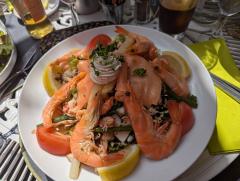 Afterward we had a nice light lunch at Les Nympheas (the water lilies), across the street from Monet's house. My Monet Salad included shrimp and crayfish with white asparagus atop a green salad, it was excellent. We don't often see crayfish in New England, and when we do it's usually not in salads or anything except a Louisiana crawfish boil, but they are cultivated in France and I saw their chopped meat used in a variety of dishes, often to complement shrimp as was done here. Since we would be heading into the apple country next, Melissa tried the Calvados, but it was strong to her taste. She and Lorna had the quiche and salad, which were good but not particularly locavore.
Afterward we had a nice light lunch at Les Nympheas (the water lilies), across the street from Monet's house. My Monet Salad included shrimp and crayfish with white asparagus atop a green salad, it was excellent. We don't often see crayfish in New England, and when we do it's usually not in salads or anything except a Louisiana crawfish boil, but they are cultivated in France and I saw their chopped meat used in a variety of dishes, often to complement shrimp as was done here. Since we would be heading into the apple country next, Melissa tried the Calvados, but it was strong to her taste. She and Lorna had the quiche and salad, which were good but not particularly locavore.
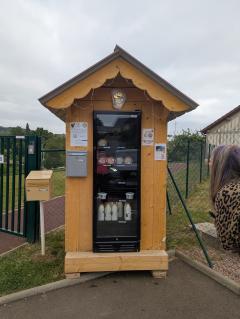 In the afternoon we drove from Giverny through busy, charmless Evreux and into the charming Pays d’Auge cheese and apple country: Camembert, Livarot, Cambremer (a place where the Calvados apple brandy is made) and Beuvron-en-Auge (called by some the prettiest village in Normandy), en route to ritzy Cabourg on the coast. In Camembert we saw this funny cheese-and-milk vending shack on the side of the road by a dairy.
In the afternoon we drove from Giverny through busy, charmless Evreux and into the charming Pays d’Auge cheese and apple country: Camembert, Livarot, Cambremer (a place where the Calvados apple brandy is made) and Beuvron-en-Auge (called by some the prettiest village in Normandy), en route to ritzy Cabourg on the coast. In Camembert we saw this funny cheese-and-milk vending shack on the side of the road by a dairy.
This was some of the nicest driving of the trip, through sleepy farming villages and among gently rolling hills covered with apple orchards and cows, and suddenly into some rugged steep terrain exposing broad vistas down to the rivers and lakes below. The roads were uncrowded in mid-May so it was relaxing and refreshing. The only thing we could have hoped for is common all over rural Europe: restaurants and cafes usually close between the end of lunch and about 7:00 PM, so cold drinks and rest rooms are hard to find during those hours.
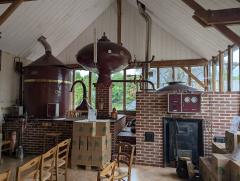 We had a particularly nice stop at La Galotiere, a maker of cider, cider vinegar, and Calvados on the way from Camembert to Livarot-Pays-d'Auge. We were greeted by Bushka, a friendly old white retriever, and we sampled their 5, 10, and 15 year-old Calvados to find one for Owen & Brigitte. The owner was very helpful and he never pressured us. We wanted the smoothness of aging but still good noticeable apple flavor, and decided upon the 10-year old. In this photo you can see the still apparatus in the back of the sampling room. Melissa also suggested the “Milk Jam”, a local confection that we bought out of curiosity, it's a delicious sort of spreadable fudge!
We had a particularly nice stop at La Galotiere, a maker of cider, cider vinegar, and Calvados on the way from Camembert to Livarot-Pays-d'Auge. We were greeted by Bushka, a friendly old white retriever, and we sampled their 5, 10, and 15 year-old Calvados to find one for Owen & Brigitte. The owner was very helpful and he never pressured us. We wanted the smoothness of aging but still good noticeable apple flavor, and decided upon the 10-year old. In this photo you can see the still apparatus in the back of the sampling room. Melissa also suggested the “Milk Jam”, a local confection that we bought out of curiosity, it's a delicious sort of spreadable fudge!
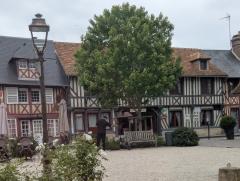 We passed through pretty but impractically-laid out Beuvron-en-Auge en route to the Grand Hotel. I had seen some travel articles calling it the prettiest village in Normandy. The buildings had the classic Norman architecture and there was a nice green in the middle of a long oval of shops, restaurants, and residences, but we were surprised to see almost no flowers, either in gardens or in window-boxes. After seeing Giverny the previous day, we expected more here. We took a loop around the center and, seeing nothing particularly beckoning us, we continued on our drive north to the coast and Cabourg.
We passed through pretty but impractically-laid out Beuvron-en-Auge en route to the Grand Hotel. I had seen some travel articles calling it the prettiest village in Normandy. The buildings had the classic Norman architecture and there was a nice green in the middle of a long oval of shops, restaurants, and residences, but we were surprised to see almost no flowers, either in gardens or in window-boxes. After seeing Giverny the previous day, we expected more here. We took a loop around the center and, seeing nothing particularly beckoning us, we continued on our drive north to the coast and Cabourg.
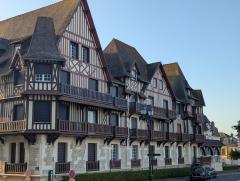 Cabourg is an orderly anomaly in Normandy. The streets are all laid out around the waterfront and the Grand Hotel de Cabourg in a semicircle. The whole place was sand dunes and fishermen's shacks before 1850. When rail travel made it possible to escape Paris in the summer, a line was laid here and the whole town was built as a planned resort community. Cabourg faces La Manche (the French name for the English Channel). The little town has a permanent population of under 4,000, which grows to over 40,000 during the summer months. We were there in late May, and it was not yet summer; there were few people and it was quite cool, with a chill breeze coming in from the sea.
Cabourg is an orderly anomaly in Normandy. The streets are all laid out around the waterfront and the Grand Hotel de Cabourg in a semicircle. The whole place was sand dunes and fishermen's shacks before 1850. When rail travel made it possible to escape Paris in the summer, a line was laid here and the whole town was built as a planned resort community. Cabourg faces La Manche (the French name for the English Channel). The little town has a permanent population of under 4,000, which grows to over 40,000 during the summer months. We were there in late May, and it was not yet summer; there were few people and it was quite cool, with a chill breeze coming in from the sea.
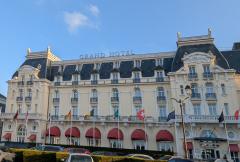 The Grand Hotel Cabourg was splendid in every way! This was a major splurge for me, a key component of my Proust Project. Our suite was two bedrooms and a generous sitting room, plus a large bath room and a separate toilet. There were plenty of closets. It was on the top floor, with windows looking northward out over the beach to the sea and westward up the beach and 'boardwalk". There was no balcony, but it was too cool to wish for one. We had all the towels and pillows that we could desire. Naturally the staff was unfailingly friendly, always attentive, and never far away. The suite was 1200 euros for the night! I said it was a splurge.
The Grand Hotel Cabourg was splendid in every way! This was a major splurge for me, a key component of my Proust Project. Our suite was two bedrooms and a generous sitting room, plus a large bath room and a separate toilet. There were plenty of closets. It was on the top floor, with windows looking northward out over the beach to the sea and westward up the beach and 'boardwalk". There was no balcony, but it was too cool to wish for one. We had all the towels and pillows that we could desire. Naturally the staff was unfailingly friendly, always attentive, and never far away. The suite was 1200 euros for the night! I said it was a splurge.
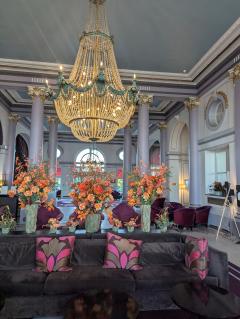 The rest of the hotel was just as splendid. It was tastefully decorated in a style that was glittering and opulent but nothing was tacky. The lobby was open and inviting, with plenty of places to sit, including a few with tables (and electrical outlets!) where I was able to sit in the morning and catch up on these notes while Lorna and Melissa were getting ready. There was a portrait of Proust; they know that they get many guests like me who would never now of their fine establishment if not for the great writer.
The rest of the hotel was just as splendid. It was tastefully decorated in a style that was glittering and opulent but nothing was tacky. The lobby was open and inviting, with plenty of places to sit, including a few with tables (and electrical outlets!) where I was able to sit in the morning and catch up on these notes while Lorna and Melissa were getting ready. There was a portrait of Proust; they know that they get many guests like me who would never now of their fine establishment if not for the great writer.
I do not know if M. Proust stayed in a room like ours, but in the book, Volume 2, In the Shadow of Young Girls in Bloom, he is an older teenage boy spending summers here with his grandmother, and staying in the cheapest room that she can endure. It is here that over the course of a few summers he falls in love with and wrecks relationships with various girls who are also summering here with their families. But most of the novel is set in high society so I was willing to spend some money for a night to get a taste of that.
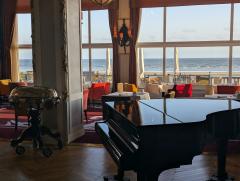 The hotel restaurant, naturally, was excellent! We had a dinner that started with amuse-bouches (they made a separate vegetarian version for Melissa), then Lorna and I shared the Salmon Trout and the Sole Meuniere. The latter was said to be Proust’s favorite, fried whole and then filleted tableside, served with Sauce Dieppoise and also browned butter - 78 euro! Melissa got a fried ravioli dish with an herby filling. We shared a La Galotiere “Les Buttes” cider (remember we had visited that cidery in the afternoon). Then the women got another amuse bouche to keep them busy until their desserts came: Lorna got a complicated structure of two single-estate chocolates on top of “aboriginal seeds”, and Melissa got a pavlova with pink-peppercorn ice cream on top of calissons, a melon-nutty flavored treat from the south.
The hotel restaurant, naturally, was excellent! We had a dinner that started with amuse-bouches (they made a separate vegetarian version for Melissa), then Lorna and I shared the Salmon Trout and the Sole Meuniere. The latter was said to be Proust’s favorite, fried whole and then filleted tableside, served with Sauce Dieppoise and also browned butter - 78 euro! Melissa got a fried ravioli dish with an herby filling. We shared a La Galotiere “Les Buttes” cider (remember we had visited that cidery in the afternoon). Then the women got another amuse bouche to keep them busy until their desserts came: Lorna got a complicated structure of two single-estate chocolates on top of “aboriginal seeds”, and Melissa got a pavlova with pink-peppercorn ice cream on top of calissons, a melon-nutty flavored treat from the south.
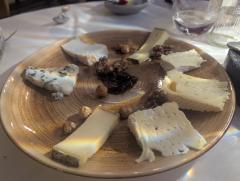 Between the main course of the diner and the sweets, we enjoyed a cheese course that deserves special mention. The "cheese trolley" was rolled in and were were able to select from 20 or so traditional artisanal French cheeses, with no limit. They were all described in detail, with some recommended as pairing especially well with our cider. We selected these seven, then the trolley departed and a little while later the waiter reappeared with this display of our selections, accompanied by some toasted nuts and fig preserves. You can see that the servings were generous, we were unable to finish it all before the sweets arrived.
Between the main course of the diner and the sweets, we enjoyed a cheese course that deserves special mention. The "cheese trolley" was rolled in and were were able to select from 20 or so traditional artisanal French cheeses, with no limit. They were all described in detail, with some recommended as pairing especially well with our cider. We selected these seven, then the trolley departed and a little while later the waiter reappeared with this display of our selections, accompanied by some toasted nuts and fig preserves. You can see that the servings were generous, we were unable to finish it all before the sweets arrived.
